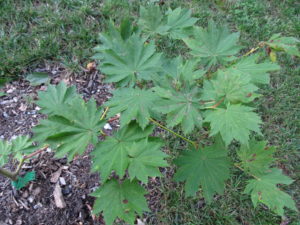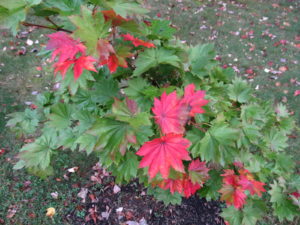At first sight Korean maple (Acer pseudosieboldianum), aka Korean fullmoon maple, is very similar in appearance to fullmoon Japanese maples (A. japonicum var. Acontifolium). If you live in a northern U.S. such as the upper Midwest, growing Japanese maples will likely become an unfulfilled wish. Korean maple is a hardier choice for northern locales (USDA hardiness zones 4-8).
Korean maple forms a lovely small multi-trunk tree or large shrub. It matures to 15-25 feet tall and 15-20 feet in spread. Foliage is similar to A. japonicum, featuring 3- 5 inch diameter circular leaves edged by 9-11 lobes. Summer leaves are a rich forest green that transitions in autumn to yellow, orange, scarlet, or red; fall leaf color is dependent on environmental factors in your area.
Korean maple prefers a moist, organically rich, well-drained soil and in full sun to partial shade. In the mid-South (zones 6 and 7) the tree does best in half-day sun. Its heat and drought tolerance across the deep South is mostly untested; likely it might prefer a dappled sun site. In colder latitudes, lay down a blanket of organic mulch around Thanksgiving to protect the tree’s root zone from temperature extremes.
Pruning needs are occasional, mostly to develop plant form and size. Korean maple has no serious insect or disease problems. On the disease side, stem canker, leaf spots, tar spot and anthracnose may occur. Watch for aphids, borers, scale, leafhoppers, caterpillars and mites.
Cultivar: ‘Ullung-do Island’ (var. ‘Takeshimense’) grows 20 -25 feet tall and 15-18 feet wide. This selection tends to grow multi-branched. It originates from the Ullung-do Island in the sea of China.



 Posted in
Posted in 
